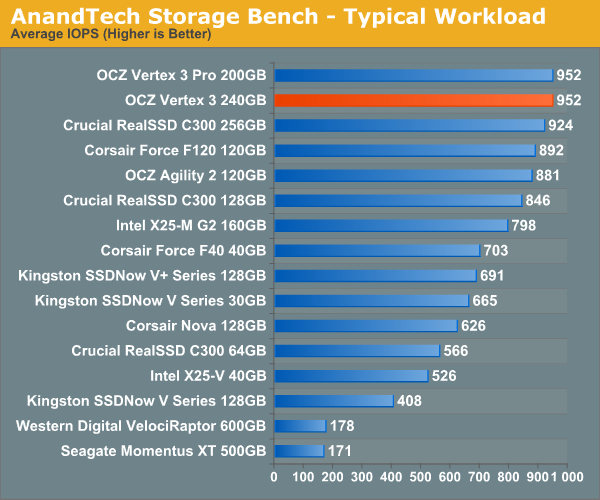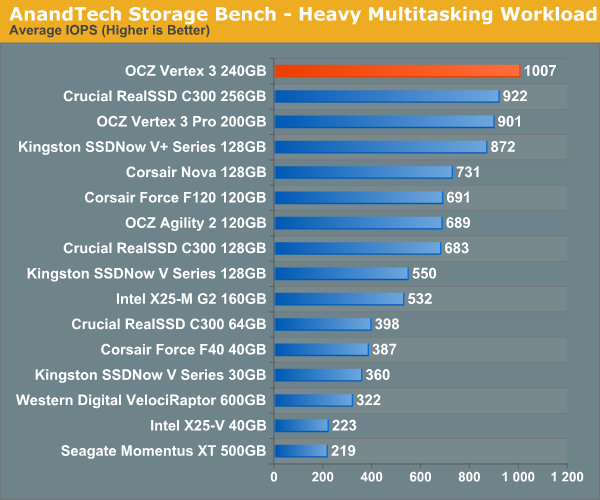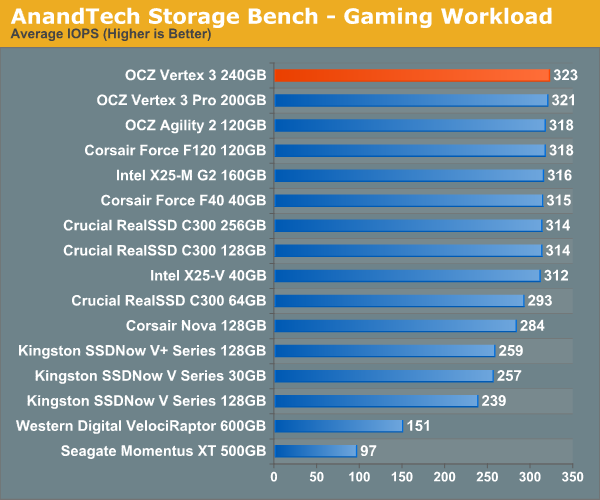OCZ Vertex 3 Preview: Faster and Cheaper than the Vertex 3 Pro
by Anand Lal Shimpi on February 24, 2011 9:02 AM ESTAnandTech Storage Bench 2010
To keep things consistent we've also included our older Storage Bench. Note that the old storage test system doesn't have a SATA 6Gbps controller, so we only have one result for the 6Gbps drives.
The first in our benchmark suite is a light/typical usage case. The Windows 7 system is loaded with Firefox, Office 2007 and Adobe Reader among other applications. With Firefox we browse web pages like Facebook, AnandTech, Digg and other sites. Outlook is also running and we use it to check emails, create and send a message with a PDF attachment. Adobe Reader is used to view some PDFs. Excel 2007 is used to create a spreadsheet, graphs and save the document. The same goes for Word 2007. We open and step through a presentation in PowerPoint 2007 received as an email attachment before saving it to the desktop. Finally we watch a bit of a Firefly episode in Windows Media Player 11.
There’s some level of multitasking going on here but it’s not unreasonable by any means. Generally the application tasks proceed linearly, with the exception of things like web browsing which may happen in between one of the other tasks.
The recording is played back on all of our drives here today. Remember that we’re isolating disk performance, all we’re doing is playing back every single disk access that happened in that ~5 minute period of usage. The light workload is composed of 37,501 reads and 20,268 writes. Over 30% of the IOs are 4KB, 11% are 16KB, 22% are 32KB and approximately 13% are 64KB in size. Less than 30% of the operations are absolutely sequential in nature. Average queue depth is 6.09 IOs.
The performance results are reported in average I/O Operations per Second (IOPS):

If there’s a light usage case there’s bound to be a heavy one. In this test we have Microsoft Security Essentials running in the background with real time virus scanning enabled. We also perform a quick scan in the middle of the test. Firefox, Outlook, Excel, Word and Powerpoint are all used the same as they were in the light test. We add Photoshop CS4 to the mix, opening a bunch of 12MP images, editing them, then saving them as highly compressed JPGs for web publishing. Windows 7’s picture viewer is used to view a bunch of pictures on the hard drive. We use 7-zip to create and extract .7z archives. Downloading is also prominently featured in our heavy test; we download large files from the Internet during portions of the benchmark, as well as use uTorrent to grab a couple of torrents. Some of the applications in use are installed during the benchmark, Windows updates are also installed. Towards the end of the test we launch World of Warcraft, play for a few minutes, then delete the folder. This test also takes into account all of the disk accesses that happen while the OS is booting.
The benchmark is 22 minutes long and it consists of 128,895 read operations and 72,411 write operations. Roughly 44% of all IOs were sequential. Approximately 30% of all accesses were 4KB in size, 12% were 16KB in size, 14% were 32KB and 20% were 64KB. Average queue depth was 3.59.

The gaming workload is made up of 75,206 read operations and only 4,592 write operations. Only 20% of the accesses are 4KB in size, nearly 40% are 64KB and 20% are 32KB. A whopping 69% of the IOs are sequential, meaning this is predominantly a sequential read benchmark. The average queue depth is 7.76 IOs.











85 Comments
View All Comments
swaaye - Thursday, February 24, 2011 - link
It'll depend on how fast your CPU is because it will become the bottleneck if it's not already.Mumrik - Thursday, February 24, 2011 - link
"Order enough controllers and you get a special firmware, otherwise you’re stuck with the stock SF-2200 firmware.(...)I do wish SandForce would just stick to a single spec and not play these sorts of games but that’s just how business works unfortunately."
Is it really? I've never heard of anything similar elsewhere in the storage space. This really sounds to me like the kind of thing you should keep pushing them on Anand....
taltamir - Thursday, February 24, 2011 - link
so... 7 "models" which are the exact same chip with different firmware / different configuration (supercap, amount of NAND, etc)And even within those so called "models" there is different levels of performance capping in firmware due to various exclusivity contracts which are not actually being reported or represented in the chip's name?
I am liking sandforce less and less.
TGressus - Thursday, February 24, 2011 - link
+1It's even more egregious when vendors are sending the reviewers pre-release samples that may or may not represent the final retail product.
taltamir - Thursday, February 24, 2011 - link
you are correct, that does make it even worse.jaydee - Thursday, February 24, 2011 - link
Interesting read from a theoretical perspective, but it would be far more useful for your readership to have a roundup involving 60-120GB SSD's. I can find benchmarks on budget video cards, cpu's, and read reviews on budget motherboards. I do realize there are no 60-120GB Vertex 3's available, but 6-9 months after launch I still have no idea how (for instance) the Sandforce, JMicron, Samsung, Indillinx, Marvell, Intel, Toshiba 60-90GB SSD's benchmark against each other considering they all scale down differently from the 240GB models which are often reviewed.240GB SSD's are neat, but not affordable for many.
86waterpumper - Thursday, February 24, 2011 - link
I agree, the 128gb size seems to be the sweet spot, that is what I've decided to go with, just not surewhether it will be the newest sandforce or the c400. I wish we could get some testing on the amd
motherboard controllers too. I know intel is more popular right now but amd is still a viable option
for many. I would think this is especially important since amd finally released a ahci driver not too
long ago, but I haven't heard much about how good it is.
ol1bit - Thursday, February 24, 2011 - link
I can't believe the jump, Intel better be on their game or they might find themselves without a market anymore.My Intel 80gb is old after 1.5 years! LOL
seapeople - Thursday, February 24, 2011 - link
Sell an x25m g2 for $1.5/GB and they are right back on top of the value/money game. Especially when you consider issues like reliability reputation versus these new drives. I wonder what the profit margin on these drives are... There might be a lot of leeway to drop price to capture market on these, considering their "real" competitors are HD's.boxleitnerb - Thursday, February 24, 2011 - link
Hey Anand,I was wondering if you're considering writing about the CPU-SSD dynamic in a future article. As I understand it, the SSDs can serve requests so fast that in some scenarios the CPU again becomes the limiting factor.
I would be especially interested in common tasks like virus scanning, gaming/application load times/installation and windows startup. I know this could be alot of work, so maybe you can pick only one or two of these tasks and analyze them with CPUs with a different number of cores and clock speeds.
What do you think about it?